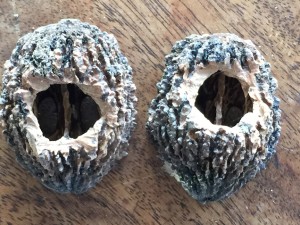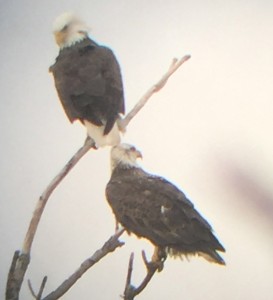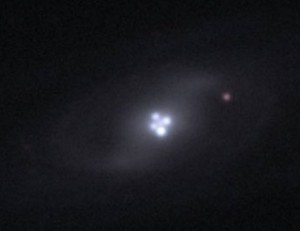I. The squirrels here love to eat the many fallen walnuts (as well as the roots of my freshly planted native plants!) even though the meat inside is protected by a very hard shell.
But the squirrel has sharp teeth and manages, with great effort, to chew right through.
 The puzzler is the many perfectly split walnuts which were lying on the ground near the end of April. The inside meat has all been eaten without a trace of tooth marks on the shell:
The puzzler is the many perfectly split walnuts which were lying on the ground near the end of April. The inside meat has all been eaten without a trace of tooth marks on the shell:
 I’d never noticed these hemispheres before. The plane of the north-south split is fairly flat, smooth and almost polished. How it happens I have no idea. I took some whole walnuts, soaked them and froze them, and hit them with a hammer – all to no avail, they refused to be smoothly split. There is some secret cleaving process at work, and I’m certain the squirrels would love to take advantage of it if they could?
I’d never noticed these hemispheres before. The plane of the north-south split is fairly flat, smooth and almost polished. How it happens I have no idea. I took some whole walnuts, soaked them and froze them, and hit them with a hammer – all to no avail, they refused to be smoothly split. There is some secret cleaving process at work, and I’m certain the squirrels would love to take advantage of it if they could?
II. The younger looking of a pair of bald eagles
 has been putting sticks against this tree on Garden Island out back for a year now without getting one of them to stay in place. This clip (click the white triangle in the middle of the picture below to play the video)
has been putting sticks against this tree on Garden Island out back for a year now without getting one of them to stay in place. This clip (click the white triangle in the middle of the picture below to play the video)
shows the bird hard at work, but at the very end the stick sadly drops to the ground once again, wasting all the effort.
It would be so beautiful to have an eagle’s aerie right here but the problem for now is how do I get the process to start? It is not an easy tree for climbing!
III. This winter’s weather has been so mild that my bees were actually gathering pollen on December 23, when the temperature was 50 F (10 C), who knows where this one found the bright yellow food packed onto her legs?
 I’ve found nothing in bloom anywhere nearby. Ever tried following the “bee line” as they leave the hive on their way to their hidden food source? I could not make it work.
I’ve found nothing in bloom anywhere nearby. Ever tried following the “bee line” as they leave the hive on their way to their hidden food source? I could not make it work.
It was so unseasonably warm that the Sandhill Cranes, who we haven’t seen for 10 years since Inez was last here from Spain, stopped by for the week of Xmas on their very late migration south.
 This photo was taken through a closed back window yet we could still here their unique chattering, clacking bills: sounded like humans squabbling about climate change.
This photo was taken through a closed back window yet we could still here their unique chattering, clacking bills: sounded like humans squabbling about climate change.
IV. Einstein very neatly showed that something with enough mass can visibly bend a ray of light. (Without any math, he simply stated that we could not tell the difference between the force of gravitational attraction and the force of accelerating a mass with inertia. So when a nearly horizontal beam of light from one wall to the other of your room seems to droop, it means either the room is accelerating upwards, or the room is being pulled down by a gravity field, which is also pulling the light beam down).
The sun at a distance of about 550 AU (Astronomical Units – 1 AU is the distance from earth to the sun) is massive enough to act as a “Solar Telescope” to form an image, of what might lie far, far behind it. The enlarged image of a bright spot behind the sun becomes an arc or a circle. A Black Hole would have a similar effect as the sun. (Radio waves are similarly bent. A good receiver at the focus spot could listen to the radio programs from another galaxy, if any planets there happened to be broadcasting!)
APOD (Nasa’s Astronomy Picture of the Day) often shows images magnified by gravitational lenses.
Einstein Rings: In the image below the gravity of a close luminous red galaxy (LRG) has gravitationally distorted, into a ring, the light from a much more distant blue galaxy which was directly behind the red one. http://apod.nasa.gov/apod/ap111221.html
 My Puzzle is that I can’t understand how this works, in even the simplest terms:
My Puzzle is that I can’t understand how this works, in even the simplest terms:
An ordinary glass imaging lens (convex) works by bending light rays to come together to form a convergent image.
 My problem with the gravitational lens is that the light rays are more deflected the closer they pass to the massive gravitational object. This results in a fanning out or diverging series of light rays and not the convergence of the rays needed to make a visible image. The rays shown below, from a star, apart from the red one which is swallowed by the BH, have an increasing bend or deflection the closer they pass to the BH.
My problem with the gravitational lens is that the light rays are more deflected the closer they pass to the massive gravitational object. This results in a fanning out or diverging series of light rays and not the convergence of the rays needed to make a visible image. The rays shown below, from a star, apart from the red one which is swallowed by the BH, have an increasing bend or deflection the closer they pass to the BH.
 Thus the massive object acts as a rather strange concave lens. I know a regular concave lens looks like this:
Thus the massive object acts as a rather strange concave lens. I know a regular concave lens looks like this:
 but its effect on a bundle of light rays should show a similar, non-imaging, divergence!
but its effect on a bundle of light rays should show a similar, non-imaging, divergence!
A simple point of light, in this case one quasar far beyond the focusing mass of a faint spiral galaxy, is often shown forming an “Einstein Cross” as 4 spots, rather than an arc or a circle. http://apod.nasa.gov/apod/ap130102.html
 That too I fail to understand!
That too I fail to understand!
Perhaps a clue lies in the gravitational images formed, not by a point mass, but by a cluster of galaxies: http://apod.nasa.gov/apod/ap990104.html
 The cluster CL2244-02 above is composed of many yellow galaxies and is lensing the image of a very distant blue-white background galaxy into a huge arc.
The cluster CL2244-02 above is composed of many yellow galaxies and is lensing the image of a very distant blue-white background galaxy into a huge arc.
Here the rays of light from a bright spot far behind the cluster mass might come almost straight through the gravitational center of the cluster with little or no deflection. The next adjacent rays would be somewhat deflected, and the next ones a little more so. Thus the central area of the galaxy cluster could conceivably act as a converging lens, but further away from the center and outside the cluster, the rays will be deflected away from each other resulting in the concave lens effect sketched above. So could there possibly be an imaging process, but only in the center of the cluster?
Any solutions to any of these puzzles will be gratefully acknowledged.
Happy Solstice, Winter Holiday, Xmas and New Year 2016 to all.
















